A Special Relationship: United States Navy and United Kingdom Royal Navy
The birth of the United States Navy in the early days of the American Revolution drew heavily on the practice, customs, and traditions of the Royal Navy. From that day onward, and through two great world wars, bonds of mutual respect and admiration have been forged between English speaking seamen the world over. May the “Nelson Touch” never be lost to us. This exhibit was a salute to the Royal Navy and the partnership with the U.S. Navy.
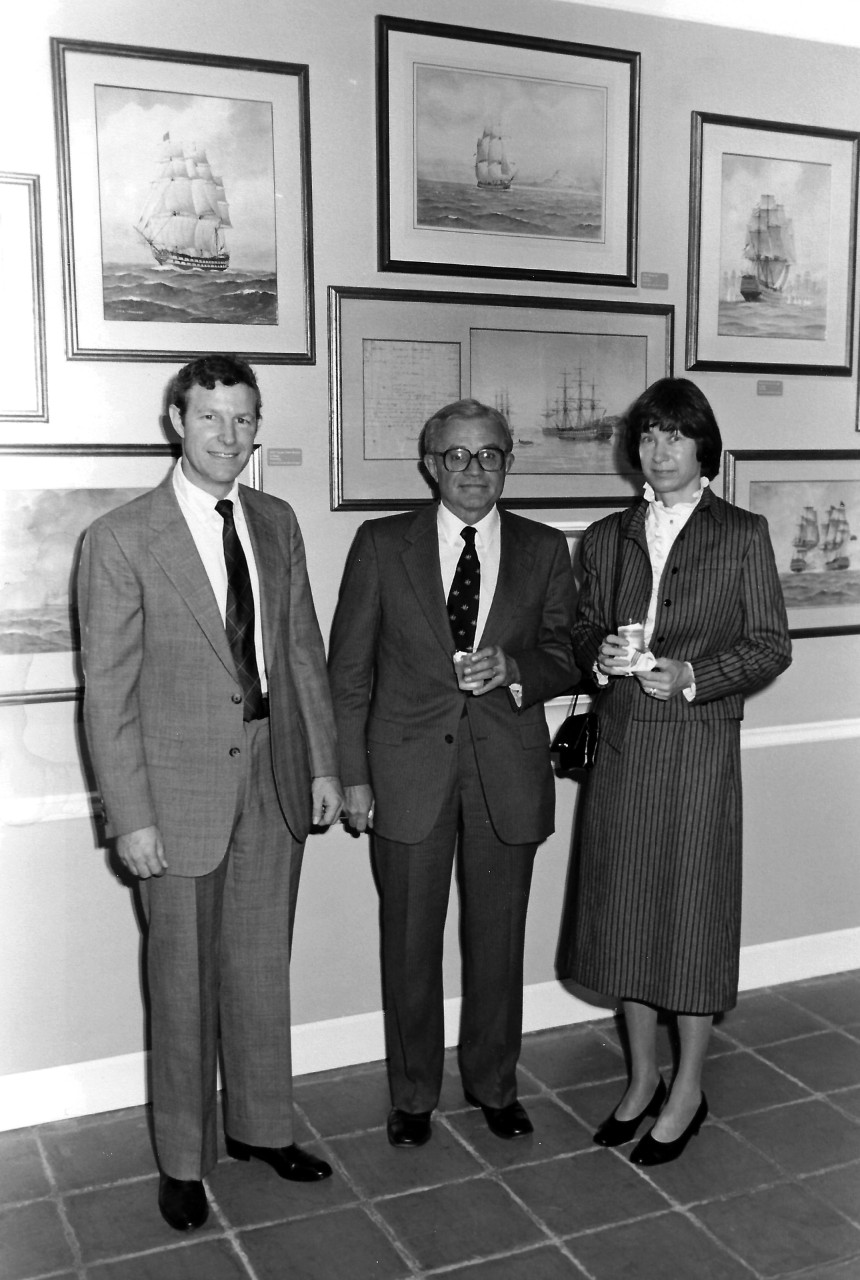
Director of the Navy Memorial Museum (now National Museum of the U.S. Navy), Dr. Oscar P. Fitzgerald, (left) with Royal Navy Art donor Mr. Melvin Conant and unidentified female invitee. They were attending the opening of the exhibit, A Special Relationship: United States Navy and United Kingdom Royal Navy, held at the museum, October 1984. National Museum of the U.S. Navy Photograph Collection, NMUSN-Photo-3.
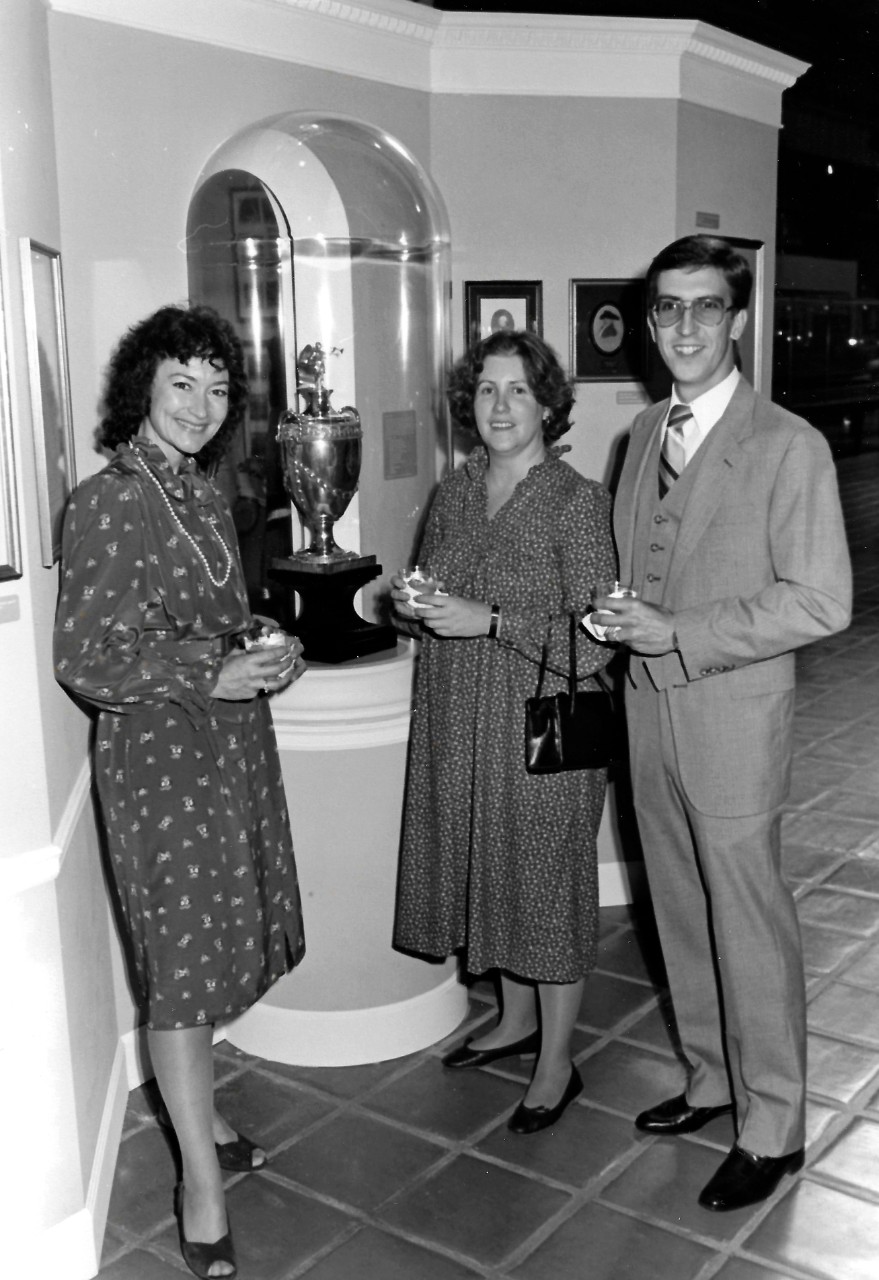
Mrs. Claudia Pennington (left), Navy Memorial Museum (now National Museum of the Navy) staff member with husband, (right), and unidentified female invitee (center). They were attending the opening of the exhibit, A Special Relationship: United States Navy and United Kingdom Royal Navy, held at the museum, October 1984. National Museum of the U.S. Navy Photograph Collection, NMUSN-Photo-4.
Exhibit Items
Artifacts
Medals
Medals Group of Commander Donald G. Irvine, USN, containing the Order of the British Empire.
Naval Crown
Heraldic device used with all Royal Navy ship emblems and symbolic of the Royal Navy.
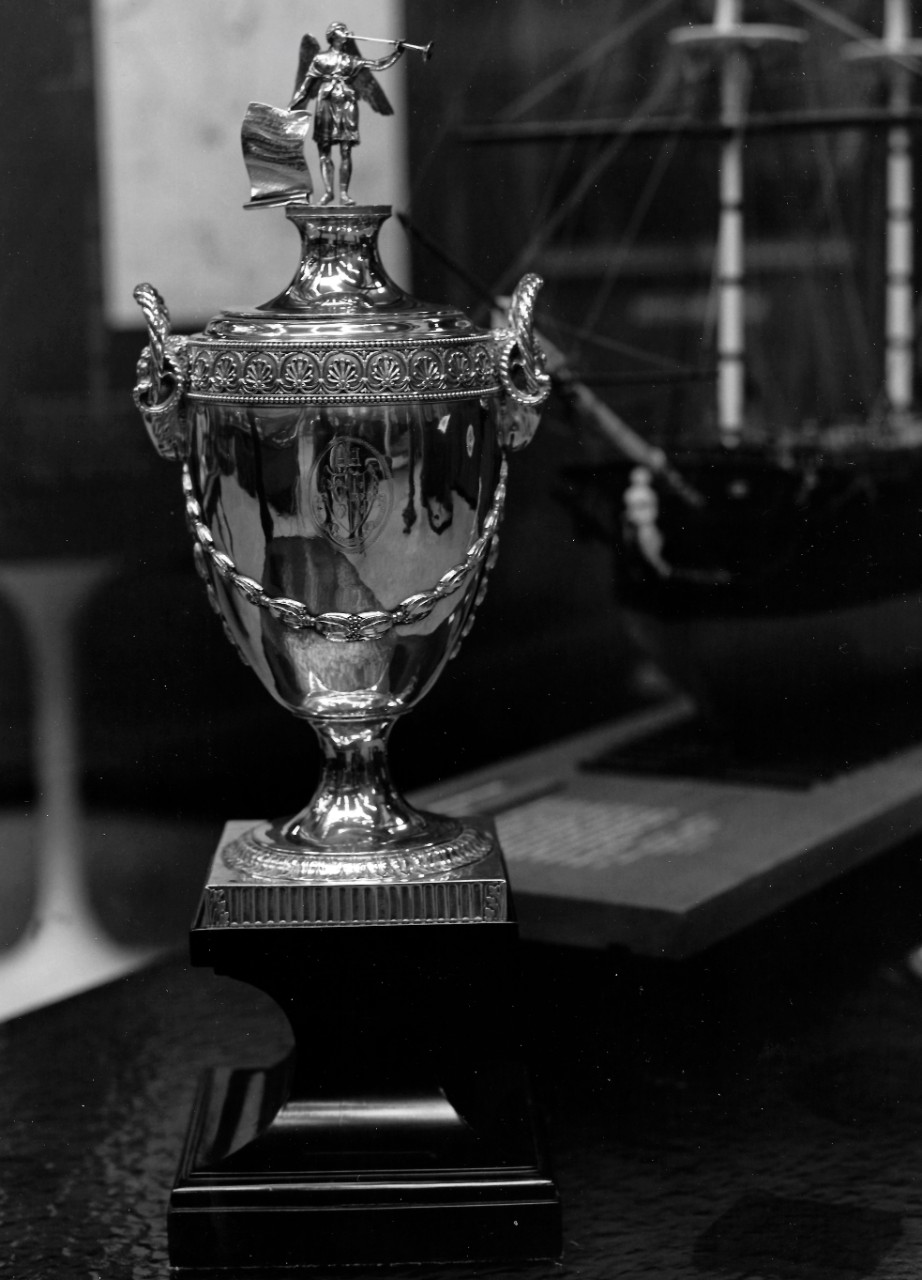
Pearson’s Cup. The Russia Company presented the cup to Captain Sir Richard Pearson in 1780 for his gallant efforts to save 41 ships carrying naval supplies. The cup is inscribed: “To Captain Pearson Knt. Who on the 23 of Sept. 1779 in his Majesty’s ship Serapis, protected a numerous & attack of a Superior force. The Russia Company, presents this vase, as a testimony of their Sense of Bravery & Conduct, on that occasion.” Courtesy of Captain and Mrs. Paul Hammond.” National Museum of the U.S. Navy Photograph Collection, NMUSN-Photo-7.
This artifact is currently on display in the American Revolution exhibit area at the National Museum of the U.S. Navy, Bldg. 76.
Sextant
The sextant, a navigational instrument, developed from the octant which was invented by John Hadley about 1731. The main difference between the two was the arc one-sixth of a circle for the sextant and one-eighth of a circle for an octant. The modern sextants have telescopic sights, but are otherwise relatively unchanged from this example made by Spencer, Browning, and Rust in London at the end of the 18th Century.
This sextant made in Bristol in 1780 belonged to Captain Samuel Tucker, who distinguished his career during the American Revolution as captain of Boston. In 1788, he carried John Adams, the recently appointed Commissioner, to France.
Ships Crest from HMS Slinger
Commissioned USS Chatham (CVE-32), it was transferred to the Royal Navy on August 11, 1943, for service during World War II and was returned to the U.S. Navy in 1946.
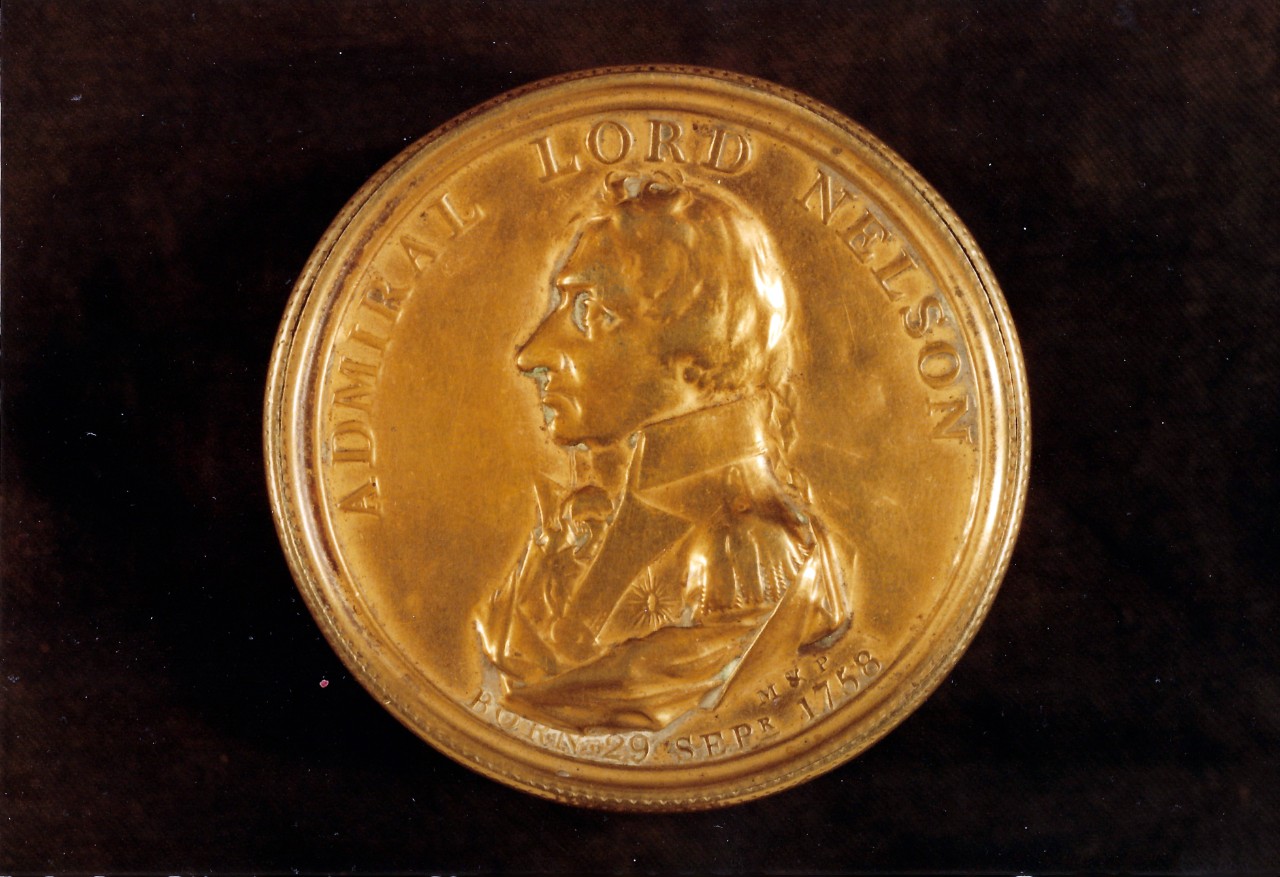
Commemorative Lord Nelson Snuff Box. Obverse side. Commissioned shortly after the battle of Trafalgar, October 21, 1805, it is inscribed “Admiral Lord Nelson, born September 29, 1758” and embossed with his profile bust. The reverse side reads, “Conqueror Aboukir August 1, 1798, Copenhagen April 2, 1801, Trafalgar October 21, 1805, where he gloriously fell.” National Museum of the U.S. Navy Photograph Collection, NMUSN-Photo-5.
Selected Artworks
Paul Jones “Commander of a Squadron of Piratical Ships”. Lithograph, published by Thomas Macklin, London.
Captain Paul Jones. Woodcut, 1799. Published by Carrington Bowles, London.
Defense of Captain Pearson against Paul Jones Squadron. Etching by John Harris, 1781.
Portrait of Rear Admiral Lord Nelson. Etching by A. Stewart Wright, 1924.
HMS Elephant, Copenhagen April 2nd, 1780. Watercolor by Edward Tufnell.
The Death of Nelson at the Battle of Trafalgar, engraving from original painting by Daniel Maclise, 1876. The original is I the palace of Westminster.
Johnny Necome in the Navy. Hand-colored etchings 1819 by John Mitford, Esq, Royal Navy.
Trafalgar 2:30 PM. Lithograph by W.L. Wyllie, 1905.
HMS Boreas, 1787. Watercolor by Edward Tufnell.
HMS Agamemnon, 1793. Watercolor by Edward Tufnell.
HMS Vanguard. Watercolor by Edward Tufnell.
HMS Victory, October 21st, 1805. Watercolor by Edward Tufnell.
Battle of Cape St. Vincent, February 14th, 1797. Watercolor by Edward Tufnell.
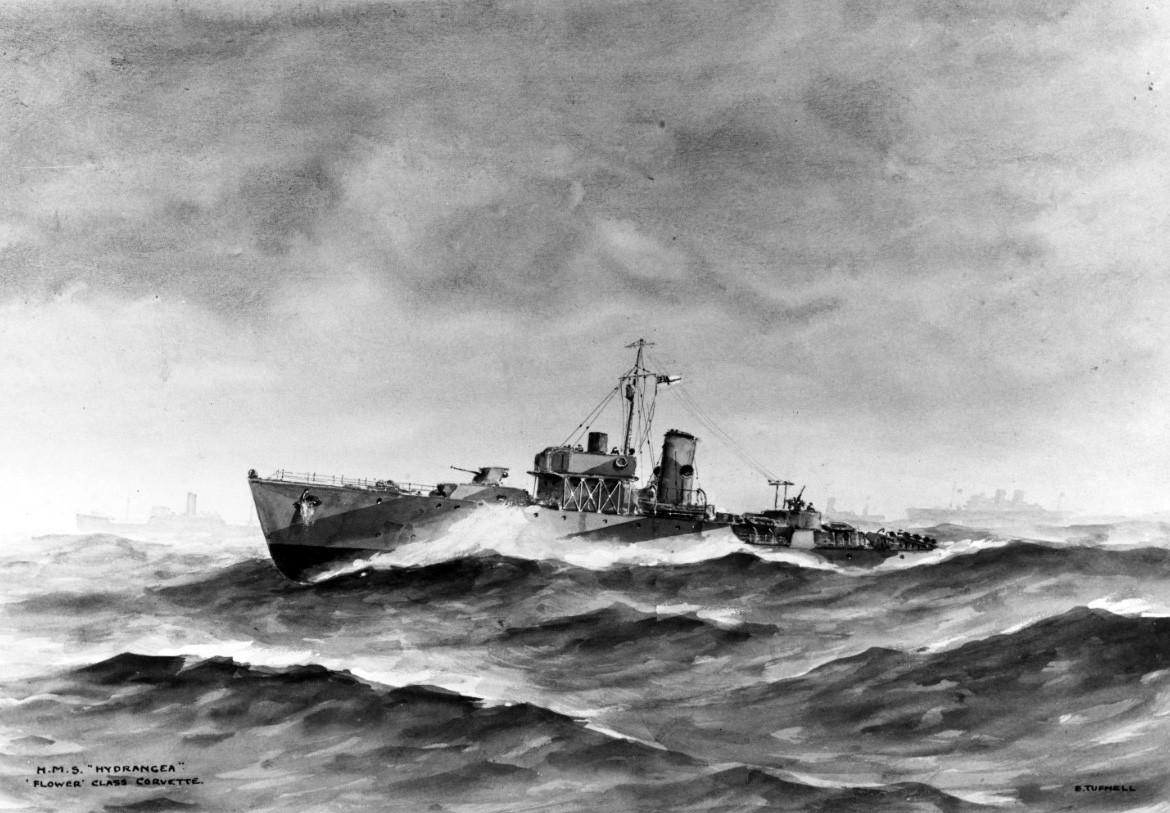
HMS Hydrangea (Royal Navy Flower-class corvette), Edward Tufnell, Royal Navy, (Retired). NHHC Photograph Collection, NH 86394-KN.
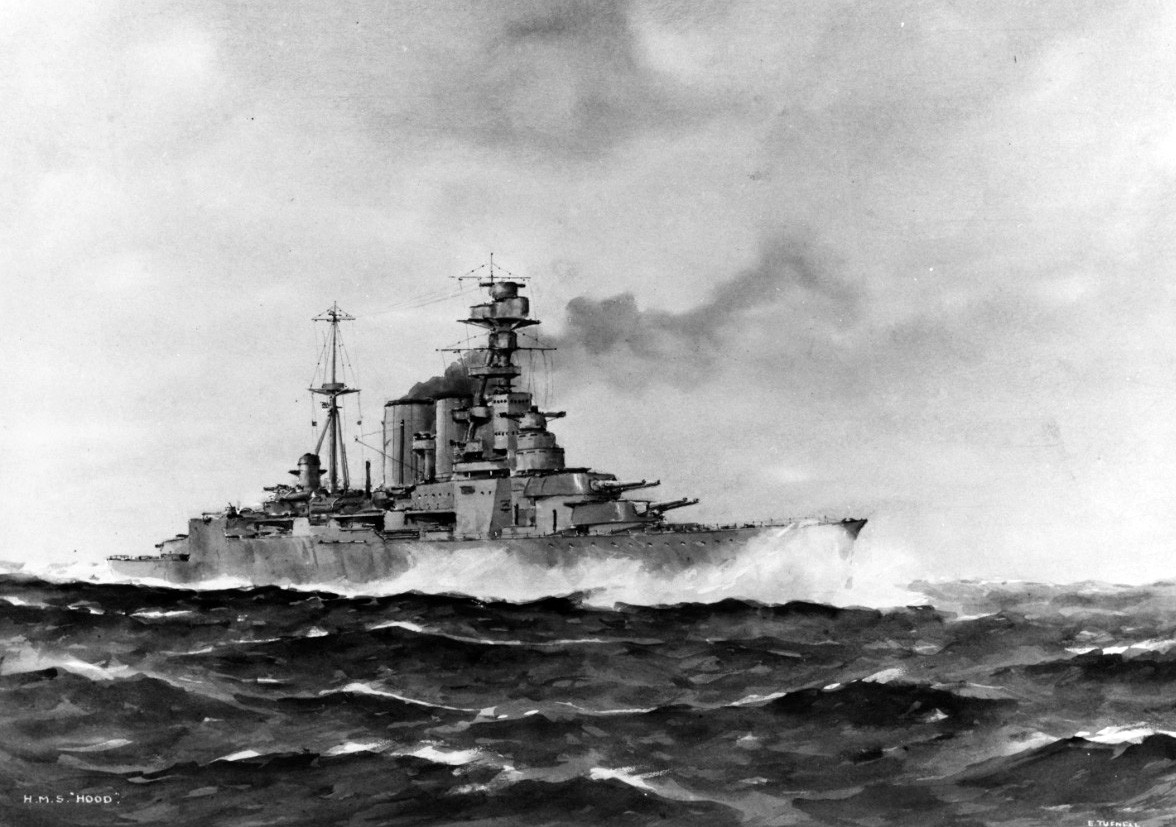
HMS Hood (Royal Navy battlecruiser, 1920-1941). Watercolor by Edward Tufnell, RN, (Retired). NHHC Photograph Collection, NH 86392-KN.
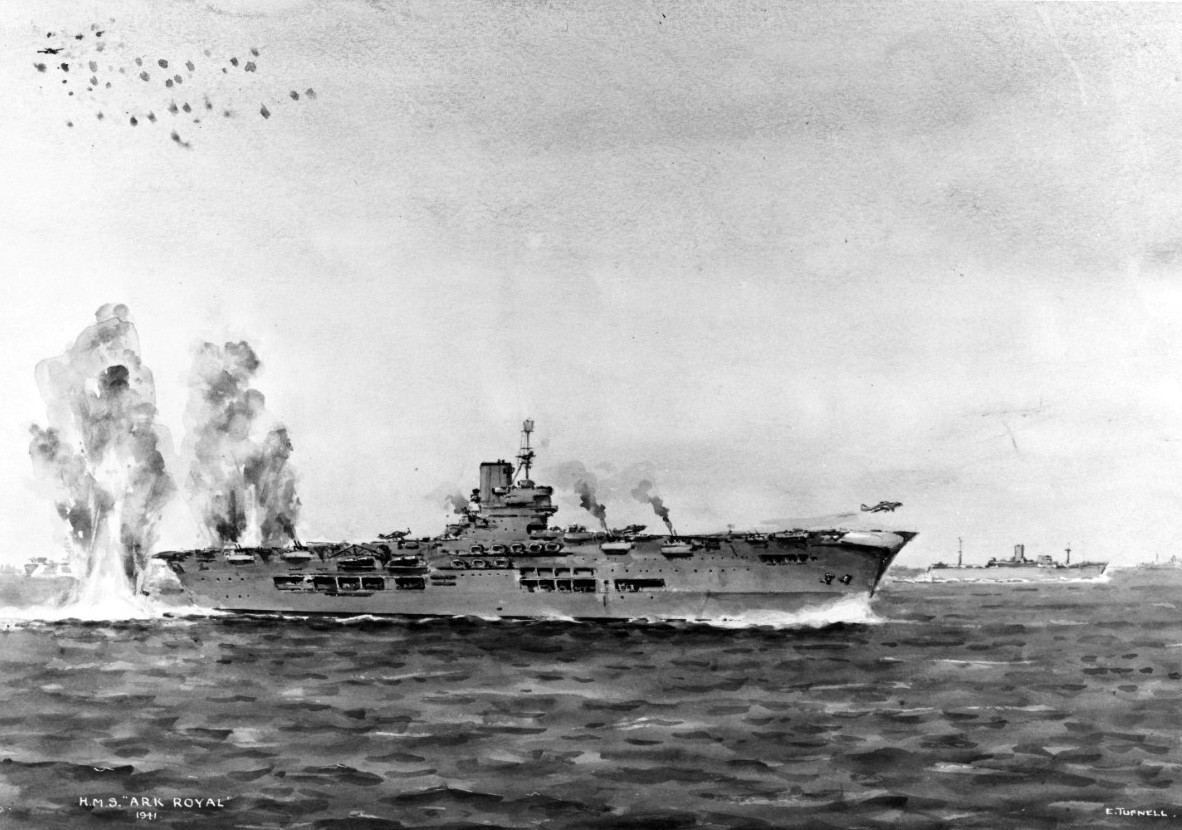
HMS Ark Royal (Royal Navy aircraft carrier, 1938-1941). Watercolor by Edward Tufnell, RN, (Retired). NHHC Photograph Collection, NH 86396-KN.
HMS Captain – Toulon Blockade. Watercolor by Edward Tufnell.
HMS Nelson. Watercolor by Edward Tufnell.
Force H off Gibraltar. Watercolor by Edward Tufnell.
HMS Exeter and HMS Achille. Watercolor by Edward Tufnell.
HMS Duke of York. Watercolor by Edward Tufnell.
HMS Queen Elizabeth, Alexandria, 1941. Watercolor by Edward Tufnell.
Convoy to Murmansk. Watercolor by Edward Tufnell.
Rum in the Royal Navy – Grog Portion
Rum was first introduced in 1655 on the West Indies Station as an alternative to beer which spoiled quickly. By the early 18th century the ration was half a pint a day, an amount which anesthetized the senses and had a disastrous effect on health. In 1740, Admiral Edward Vernon ordered the rum watered down as “a remedy for the swinish vice of drunkenness” The mixture of a quart of water to each half pint of rum was prepared in a cask or scuttle butt in the presence of the Lieutenant of the Watch. This was the original “Grog,” deriving from the Admiral’s nickname Old Grogram, which described his coarse, silk boat cloak. In 1842 the ration was again halved, and in 1970 after more than three centuries of use in the Royal Navy, the rum ration was abolished altogether.
Following the British traditions, the American Navy issued a daily grog ration until 1862 when President Abraham Lincoln ordered the practice to cease. Liquor was still used in the officer wardrooms and captain’s mess until 1914 when Secretary of the Navy, Josephus Daniels, issued an order to ban alcoholic beverages from all ships and stations of the U.S. Navy.
Courtesy of Admiral Jerauld H. Wright, USN, (Retired).
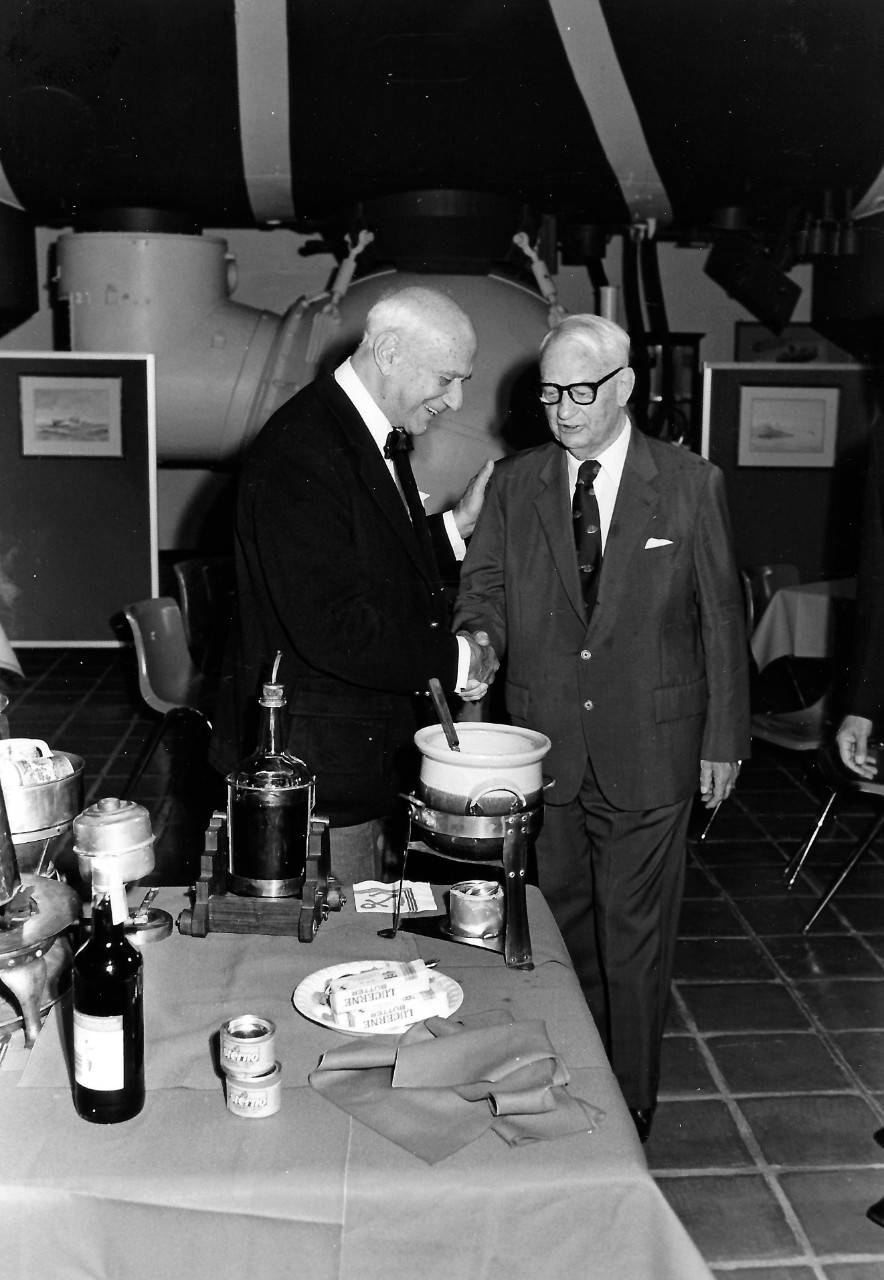
Admiral Arleigh A. Burke, USN, (Retired), right, and Admiral Jerauld Wright, USN, (Retired), at the opening of the exhibit A Special Relationship: United States Navy and United Kingdom Royal Navy held at the Navy Memorial Museum (now National Museum of the U.S. Navy), October 1984. They are discussing “Grog”, which was part of the exhibit written by Admiral Wright. Note, bathyscaph Trieste in the background. National Museum of the U.S. Navy Photograph Collection, NMUSN-Photo-1.
Textiles:
The Laws of the Navy.
Dedicated to his comrades in the service by the author, Rear Admiral Ronald A. Hopwood. The poem appeared originally in the Army and Navy Gazette, July 23, 1896.
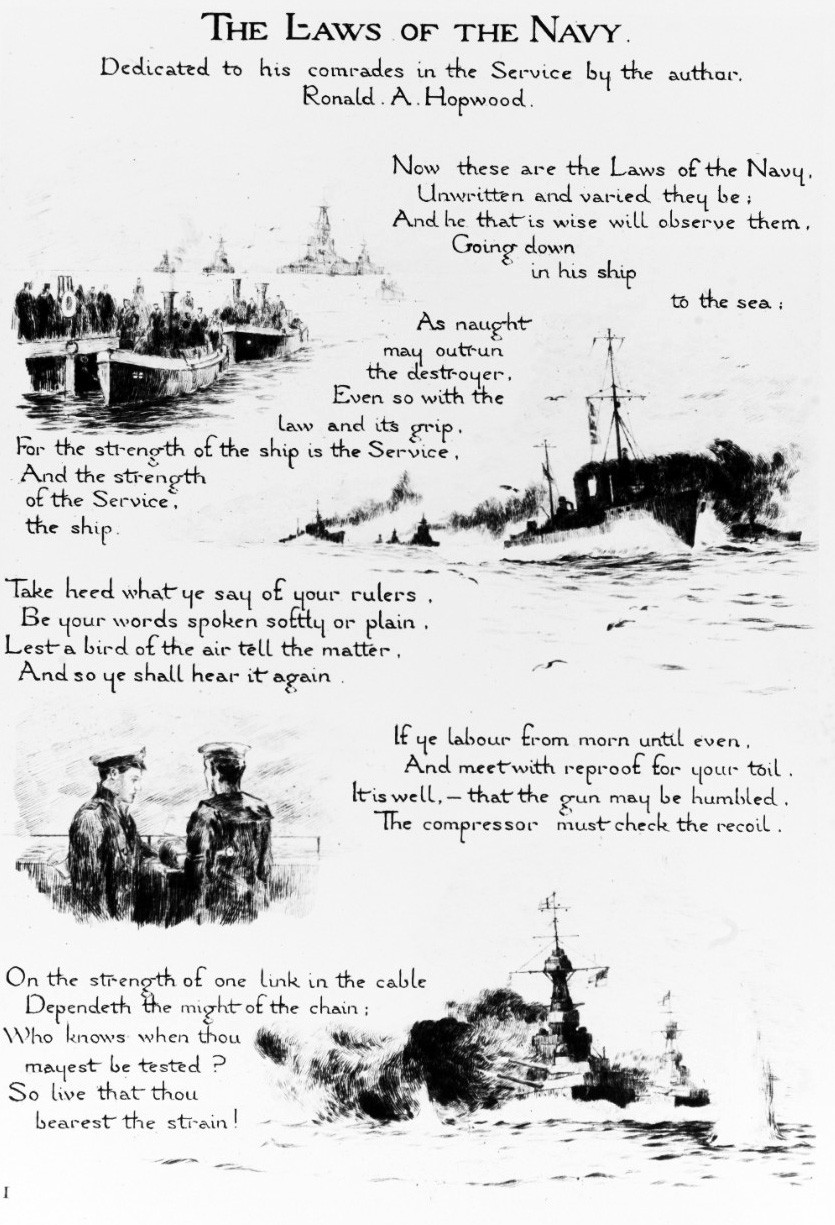
NH 41883 The Laws of the Navy Plate I (of four) of an edition of the poem by Rear Admiral Ronald A. Hopwood, C.B., Royal Navy, published by W.R. Deighton & Sons, London, England, during the World War I era. It is illustrated by etchings by Lieutenant Rowland Langmaid, R.N., depicting scenes of the contempory British Navy. The poem originally appeared in the Army and Navy Gazette, 23 July 1896. U.S. Naval History and Heritage Command
British Order of St. Michael and St. George
Presented to Captain J.R.P. Pringle, USN, for service during World War I.
The Navy List, October 1917
Published by Admiralty, it contains the unique listing of Captain J.R.P. Pringle as Chief of Staff to Vice Admiral Sir Lewis Bayly, the senior Royal Navy officer in Queenstown. The Irish port was one of the major U.S. bases from which the U.S. Navy joined the British to mount patrol and convoy and escort operations. Captain Pringle represented Admiral Sims who was the senior U.S. Naval officer in Europe during World War I. Courtesy of Rear Admiral and Mrs. J.D.H. Kane.
Letter forwarding Navy List to J.D.H. Kane
Containing the comment pertaining to the uniqueness of a U.S. naval officer, her father, being listed as Chief of Staff to a British admiral.
Order of Funeral Arrangements for Vice Admiral Horatio Viscount Nelson
Seal of the Unites States Navy



